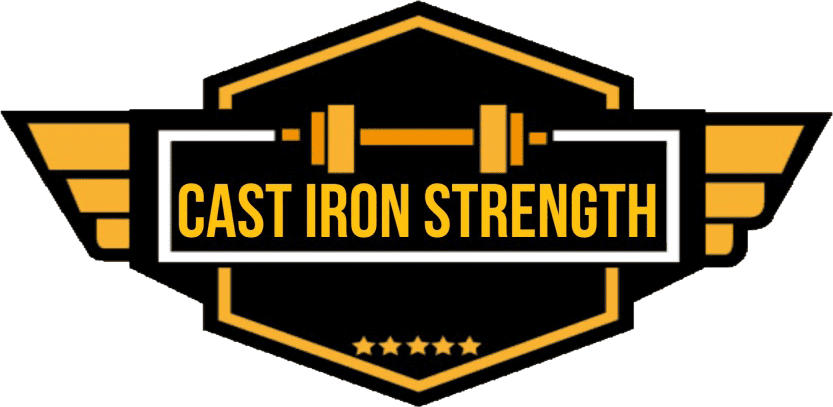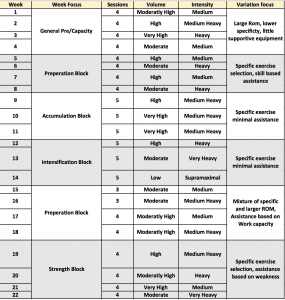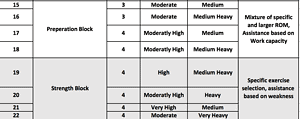If you haven’t read the previous post where we laid out in brief detail the terminology and gross block design goals then please go back and read over part 1
So we have laid out in brief detail some of the thinking behind periods of training, their focus and how they can be strung together for better effect. What we will do now is pull it into context. I am not going to lay out each block in detail that can be an article for a future period or more likely for my upcoming book.
So you need to, first of all, understand the context you are going into this means the time frames you have to work with and what obstacles if any are going to get in the way in your training or the training of your athlete. Of course, you can’t foresee things such as injury and illness these are going to happen so there is no point really thinking about it. When they happen how to deal with these issues is a separate topic again we can cover in detail separately.
To put some flesh to the bones as it where I will now lay out two scenarios on for an intermediate trainer with no competitions coming up looking to progress as much as they can over the following 24 weeks and the second scenario will be for a lifter with two meets coming up the second of which will be the important competition.
Training to maximise strength gain with no competitions in sight.
If the goal is just straight strength gain then you can take a couple of variant approaches you can run overreach or overload based training back to back an example of this kind of training would be someone re-running a programme like 5/3/1 over and over again increasing working loads from block to block. This approach is valid and works but it doesn’t have any sensitivity to where the lifter is at and it doesn’t allow the blocks or weeks of training to complement each other or lead to an increase of boost in performance.
In the above planned period of training, you will see it is split into what you could define as 3 distinct periods of training.
Week 1-8
There is a general preparation block moving into a preparation block. The rationale would be that the work capacity block will increase the lifters ability to handle the volume or their lifting fitness substantially but will use less specific variations and involve lesser specificity to allow for the block to increase the overall muscular demand of the training. This might be a decrease in the time spent specifically preparing for the powerlifting movements but the mental break and reduction in the wear and tear on joints and muscles from the typical specific training cannot be underestimated in its effectiveness for freshening up a lifter for training and helping to prolong their injury-free career.
Coming off a work capacity block most lifters will be a bit rusty when it comes to the competition specific form they use for squat bench or deadlift (or whatever their sport is). Undergoing a period of specific preparation based around improving the lifter’s skill level can help to bring them back up to speed from a co-ordination standpoint and give them a stable, efficient and trainable technique which will give them a much better platform from which to push themselves in overload based blocks.
Week 9-14
This is effectively one 6 weeks overreach block. The first 3 weeks is what is known as an accumulation block where the lifter will undergo an unsustainably high workload which will lead to deliberate accumulation of fatigue. This will lead to their performance being suppressed on an acute basis (they will feel slow, sluggish and tired) however they are accumulation the fatigue/stress to allow them to spring forward in the second part of the block.
After the three-week accumulation block, the lifter will then be entering into the intensification phase which is a taper in all but name. Typically volume will decay every week by about 10-25% depending on the program or overreach block. Towards the end of intensification block the lifter still might feel a bit chewed up or sluggish bit they will see a huge increase in their acute performance. An outright increase of 5-10% is not uncommon for most overreach programmes. It might take some time for the increase in fitness to normalise and for the lifter to make it routine but it can definitely help break new ground and can be utilised for important competitions to largely increase performance levels.
Week 15-22
The final 8 weeks of the block contain a preparation block where the lifter can take away the belt or supportive equipment and then retune their technique. There can be a tendency for a lifter’s technique or execution to lessen accuracy when they are under a high amount of stress. Spending 4 weeks just revisiting some of the technique cues or readdressing weaknesses you have in the execution of your lift. This again will help to make sure you are moving as efficiently as possible allowing you to take advantage of any overload or stress coming in your program.
Finally, the lifter will follow on with a 4-week strength block this will be a less intense period of overload which will allow them to push on from the level they have achieved 6 weeks ago during the overreach block. The gain that should be expected should be much lesser than the intensive 6-week block but the stress loads undertaken in such a block aren’t sustainable but when used in the correct order can help a lifter take a jump in their strength levels.
Training to maximise performance in competition.
When you are training towards a competition the goal posts change slightly, your timelines change and the importance of building capacity shifts to the side in importance in favour of your ability to show your strength. There will still be some room to build your strength in the build-up towards a competition depending on how far away you are. If your competition is coming up in 4-6 weeks then you aren’t really going to be able to make a lot of strength game in that time frame but by making sure you are priming yourself in the run-up to the competition and ensuring you are controlling fatigue appropriately you can give yourself the best opportunity of giving the best performance you are capable of on the day.
In our example, we have 19 weeks of notice before our first highly important competition of the year we also have a much less important competition in the calendar that we have to do. This can be the case for lots of lifters maybe they need to do it as a qualifier for a more important competition later in the year or calendar.
Week 1 to 3
This is a small preparation block leading into the first competition it will utilise an undulating intensity and volume model moving from a volume focus to an intensity focus from week to week. The assistance exercise and main exercise will be based on skill learning and developing the base for the upcoming specific preparation block going into the first less important competition.
This block can be performed beltless to help the lifter develop better coordination and to condition their trunk in preparation for the heavier training to come. Since the competition coming up isn’t of high importance doing a preparation block who’s results might not be seen till much, later on, isn’t too much of a problem as the real goal is the competition coming up in week 19.
Week 4-7
The next block leading into the competition of less importance will look to use the competition in week 7 as a heavy workout. The first week of the block will be the first intensity week of the block followed up by two volume block leading to the final intensity week which will also contain the competition.
Exercise selection will be focused around competition specific variations and competition preparation so bench presses will be paused, squats will be done with belt and sleeves and a go volume of deadlift will be done as singles or resets without straps being used. The first week will give coach and lifter an idea of what they will be aiming for at the competition at the end of the block. They will be looking to lift up towards second attempt territory.
The following two weeks (week 5 & 6) will act as a volume accumulation leading to the competition week. Ideally, the lifter should go through a higher volume of work in this block than in the previous three-week preparation block.
Come competition day the lifter will go 9/9 outside of some technical fails getting in the way of this coming to pass. The attempts that will be made should be well within the lifter’s capability of making with the third attempt representing a RPE single of around 9-9.5. The reason being that competitions even ones where you don’t push at maximal capacity are more stressful than training in any scenario. By pushing to a daily max or failing in the competition will negatively affect the upcoming 2-3 weeks of training which is not a sacrifice we want to make for a lesser important competition.
Week 8 – Recovery week – this is not a week off but will represent a down week where non-competition variations of the lifts will be utilised to load the body in a different way than powerlifting specific training and both volume and frequency will be at a moderate level which should help to freshen up the lifter.
Week 9-12
This block is a more traditional strength block again utilising and undulation weekly between volume and intensity focus week to week. This block will utilise belt and knee sleeves (although the lifter may wish to ditch supportive equipment for another block of training for their own reasons and this would be fine) the lifter should be looking to again accumulate more volume of work in this block of training than the previous 4 week block which included the competition.
The volume of work is probably more important than outright intensity depending on the lead into the previous competition the lifter will have gotten close to 95-105% RM and may have managed to increase their competition performance with more left in the tank. Depending on how you programme you can include 90%+ work but need to ensure that you aren’t causing more fatigue than is necessary in the context of the block. You may want to consider using singles practice with and RPE bracket between 8-9 or 85-90% although I much prefer RPE for regulation of singles as it is more sensitive to the lifter’s current level of preparation and allows for self-regulation.
During this period of training, it is important for the lifter to accumulate a sufficient amount of work to progress in their strength levels but also to build up some momentum with their training so they are moving well and are prepared for the upcoming tough block of training.
Week 13 – Recovery week – this is not a week off but will represent a down week where non-competition variations of the lifts will be utilised to load the body in a different way than powerlifting specific training and both volume and frequency will be at a moderate level which should help to freshen up the lifter. The level of work will be reduced when compared to week 8 to ensure the lifter is coming into the final block of training fresh and ready to push on.
Week 14-19
This is what is known commonly in powerlifting circles as a “peaking block” some of the peaking blocks you will see online a good example of which would be Ed Coan’s 10-week preparation for competition you can see on this very website take the form of a linear build up. That is to say starting from a period of high volume onto a period of lower volume with a build up in intensity. This kind of programming will work well for the beginner lifter or for the enhanced lifter (read lifter on steroids) as they have the endocrinology or are in a place where they will pretty much respond to any training stimulus or will adapt to any workout as long as it is stressful enough to produce an adaption response for the better-trained lifter or athlete they will not respond linearly to this kind of training they will require more variation in their loading and will require a higher training or stress load to produce adaptation.
This is where the “peaking” block comes in basically we will be using the overreaching principal we discussed earlier in part 1 of this series to produce a spike in performance come competition day. This is maybe something you don’t want to do if you are an enhanced lifter or as a beginner as it will drastically raise your risk of injury for maybe not a better outcome. For the experienced and well trained natural athlete, it’s a quirk of physiology that can let them produce a better performance than is above their current ability. This increase in performance is a transient or impermanent increase. If you have ever completed smolov managed a big increase in your max and they weren’t able to sustain this increase then what you have experienced is the effect of overreach and the subsequent peak in performance that happens. However, what goes up must come down and overreaching in training is by its very definition not sustainable so you can’t utilise it as a mainstay in your training. I personally would advise using an approach like this 1-2x per year and saving it for important competitions or performances.
The first three weeks are where the loading occurs the better shape the lifter can make it to this point of the training the better the result of the peaking block will be. The lifter should have full knowledge that they are entering into what will be a mentally and physically challenging 6 weeks and they should be given instruction to use the proceeding block to make sure their movement is as close to perfect as they can make it and they are executing lifts with speed on the concentric and accuracy on the eccentric.
The first three weeks will be attritional in nature and they will probably want to make use of restorative strategies such as massage, skins and heat therapies whatever they believe to work the best. Each workout should look near impossible, be achievable and make the athlete feel tired. Once they get through the first three weeks of training the lifter will feel beaten up and probably a bit mentally fatigued, this is the accumulation phase of the block where the lifter is going to do the vast majority of the work.
The next three weeks are the coach or programme taking their foot off the back of the lifter’s throat and allowing them some air. There should be a drop off of between 25-30% in total volume per week and an increase in average intensity. The drop off in volume and the rise in intensity should be steep.
The final week leading into the competition will be more or less complete rest with 1 or 2 sessions depending on how the athlete likes to taper. The intensity of these sessions will be controlled and lower than training volume for this week will be 40-60% less than any normal training week to allow a good taper effect.
Coming into the competition the athlete should set their attempts expecting a sharp increase in their capabilities, the size of which will depend on how the block has gone.
This is a peaking block and isn’t the safest strategy in the world the chance of a novice coach or athlete getting this approach wrong are very high.
Finally, after the competition the lifter will be advised to take an active week off meaning they can still exercise but stay away from heavy powerlifting. Depending on the length of the season this might be a 2-3-week period of active detraining for powerlifting.
Hopefully, these two articles have given you a better understanding of how to put together the bigger blocks in training organisation. Next in this vein of writing I will cover the 3-6 weeks sized period of organisation.
Marc










